Know
Rescue on Clearwater Beach: Another dolphin tale
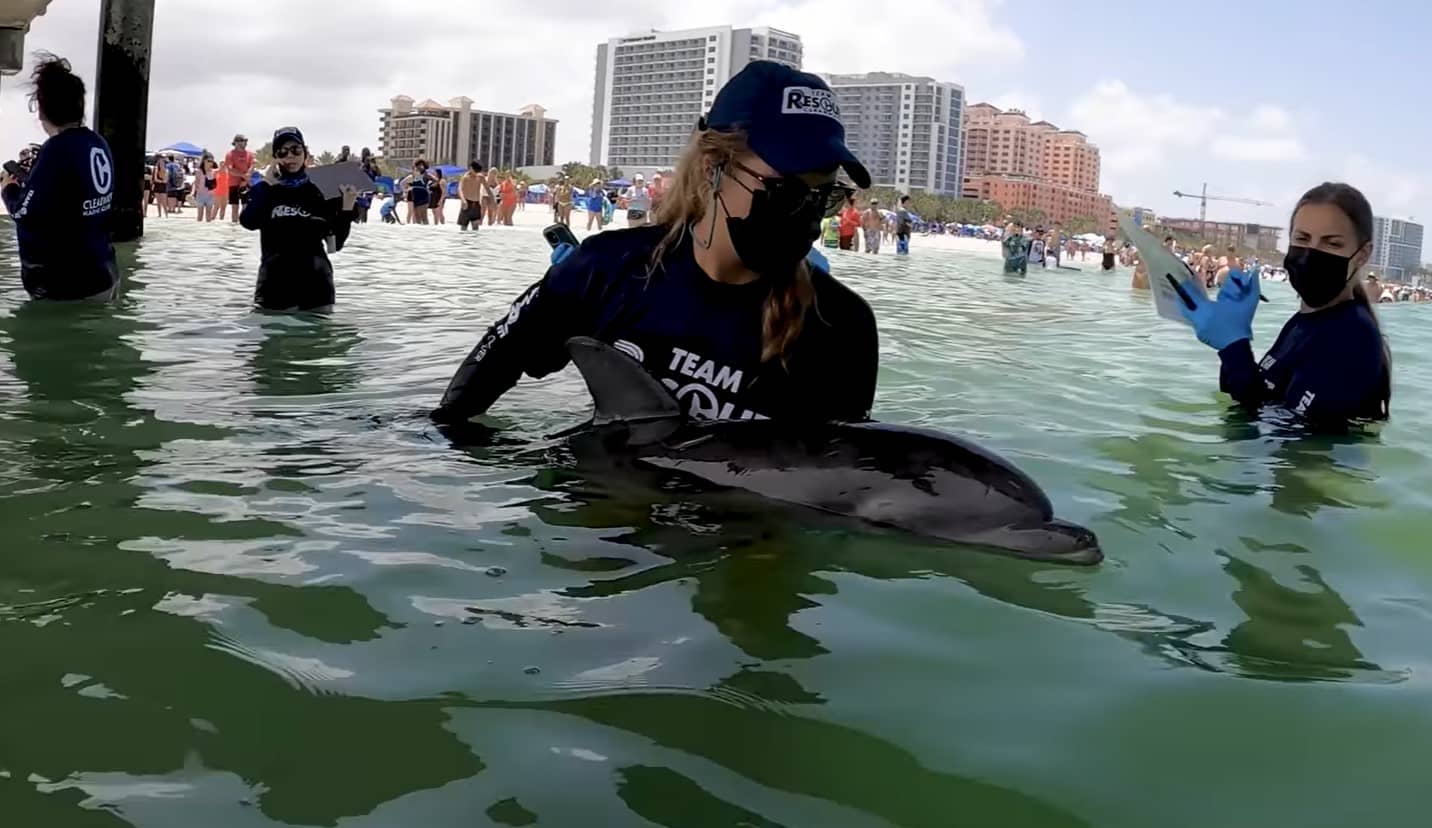
Clearwater Beach Patrol lifeguard Justin West was three hours into his shift Wednesday afternoon when he noticed a bottlenose dolphin in the green water off Pier 60, the elevated tourist and fishing structure. A common sight, as the the sleek, grey marine mammal is indigenous to the coastal Gulf, and the pier stretches more than 1,000 feet offshore.
This one, however, appeared to be swimming in circles. As if it was looking for something.
Using his binoculars, Justin West saw something else: One of the Styrofoam crab trap buoys under the pier was bobbing in an erratic fashion. He saw a shadow underneath it, but even with binoculars, it was too dark down there to make it out.
He climbed down from his Tower 5 perch, hopped on his rescue board and quickly paddled out to investigate.
He had shears with him; a necessary tool for freeing birds entangled in fishing line. That sort of thing, unfortunately, happens all the time.
“I paddled out until I got within 20 feet of it,” West recalled, “and I went ‘Oh gosh, this is a dolphin.’” A very, very small dolphin. A baby. Immediately he surmised that the animal he’d seen swimming in circles must have been its panicked mother.
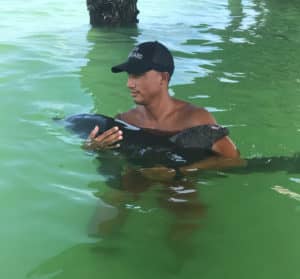
Clearwater Beach Patrol lifeguard Justin West. Photo: Clearwater Fire & Rescue.
The baby was in distress. “One line was wrapped around the piling, and the dolphin’s tail was wrapped up in the other line, like six times. It was really tight. And every time it would try to swim up to get a breath, it would get yanked back.”
As adrenaline pumped, he realized he was unsure of the water’s depth. “I knew I couldn’t cut it from my board,” West said. “So I jumped off, and I was able to stand.” It was, he estimates, between four and five feet deep, on a sandbar that transects the pier about 200 yards out. He was able to free the line caught on the piling; the rope around the animal’s tail, however, was too tight for shears. So he signaled to Scott Mattis, another lifeguard, to bring a knife. Together, they cut the second line and the crab trap fell away.
Clearwater Beach Patrol lifeguards are employees of the city’s Fire and Rescue Department. “They’re hoping the adult, possibly the mother, comes back,” read a department tweet.

Onlookers were kept back as the calf was assessed. Photo: Clearwater Fire & Rescue.
With the dolphin freed, the lifeguards set it gingerly on West’s board for the journey closer to shore, guiding it across a wide, deep-water trough and into the shallows where maneuverability would be better. There, as West and fellow lifeguard Georgia Toney kept the animal stable on the rescue board, Mattis removed the rest of the stiff nylon rope. Someone called the nearby Clearwater Marine Aquarium, an authorized rescue facility.
“They took a while,” according to West, “so they told us to hold onto the dolphin – and since I had the dolphin in my arms, we weren’t going to switch it up. So I held onto the dolphin, in the shade, and just tried to keep it comfortable. Made sure it stayed alive.”
He was on his knees in the shallow water, cradling the 60-70 pound animal and ensuring its blowhole remained above water, for what he estimated was almost an hour. “That was a new one,” West laughed. “I never got to do that before.”
The baby was silent until the CMA team arrived. “At the transfer,” said West, “the dolphin started being vocal, like ‘what’s going on?’ They said ‘Man, you’re like the dolphin whisperer! He was nice and quiet with you.’”
This scenario was eerily similar to the discovery of Winter, the bottlenose dolphin rescued on Florida’s east coast in 2005. Approximately two months old, she had somehow wrapped her tail around a trap line, cutting off the circulation. Shortly after her rescue, Winter’s tail literally fell off.
She was fitted with a prosthetic tail, and thrived at the Clearwater Marine Aquarium for 16 years, appearing in two popular Dolphin Tale movies. Winter died, of an unrelated illness, in 2021.
Wednesday afternoon, the adult dolphin hadn’t been seen since the lifeguards first intervened.
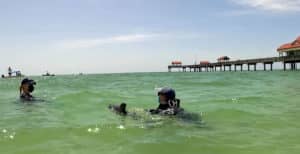
Monitored by boat, an attempt was made to let the baby return to its mother in the wild. CMA video screengrab.
Even so, CMA reported on social media, “although the mother had left the area, the team attempted a release with careful monitoring by boat to give it a chance to reconnect with its mother in the wild. Unfortunately, upon release, the animal struggled to swim in the open water.”
It was unclear how long the male calf had been fighting the weight and tug of the trapline, but it was showing signs of stress. Its energy was low, noted the rescue team, and its breathing seemed labored.
Still, the marine biologist’s perfect world scenario is to interfere with nature as little as possible.
By this time – somewhere after 3 p.m. – since the adult dolphin was no longer in the area, and the infant was showing additional signs of weakness, a decision had to be made.
The Clearwater Marine Aquarium is an accredited member of the Southeastern Marine Mammal Stranding Network, which is overseen by the National Oceanic and Atmospheric Administration (NOAA). As such, CMA is authorized to respond to sick, injured, stranded or dead marine mammals under the Marine Mammal Protection Act, Section 112c.
“After consultation with NOAA,” CMA officials said later in a prepared statement, “the calf was transported to the closest authorized Marine Mammal Stranding Network facility that was open for rehabilitation, SeaWorld Orlando.”
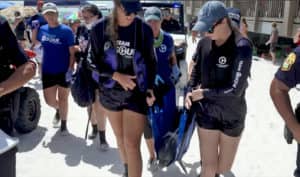
Clearwater Marine Aquarium screengrab.
The baby was placed on a transport stretcher and removed from the area at 3:50 p.m.
It was unclear why the NOAA did not instruct CMA rescuers to transport the injured annual to its own marine rehabilitation facility, which opened three years ago at Fred Howard Park in Tarpon Springs.
SeaWorld immediately listed the calf’s condition as “critical.”
On social media channels, the public’s concern was immediate and overwhelming.
Facebook: “How do you guys know when a baby dolphin is allowed to be released on its own especially if it still potentially relies on its parents?”
Clearwater Marine Aquarium response: “In most cases, release after rehab is ideal. Calves spend the first few years learning life skills necessary to survive in the wild, therefore experts will discuss if this option is a viable one for this individual animal.”
Friday morning, the Catalyst received this email from SeaWorld Orlando: “Animal still in extremely critical condition and receiving around the clock care. We do not have additional details to share at this time.”
For Justin West, an eight-year-veteran of the Clearwater Beach Patrol, this was a one-of-a-kind experience. “I’ve helped pelicans and cormorants, other birds, but never held on to a dolphin,” he said. “I maybe touched a dolphin at an attraction once, when it swam by.”


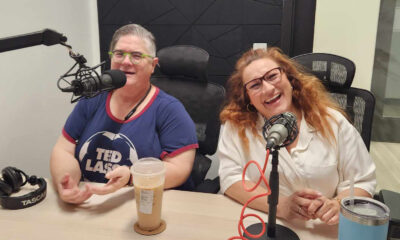





Brenda bell
August 3, 2022at10:04 pm
I totally 💯 agree with the lifeguard that the dolphin 🐬
Needed rescuing from dehydration
Sharon Marshall
July 28, 2022at7:37 pm
Jodi!! You will be a HUGE HERO!! We can name it Jodi’s LAW!! You deserve that!! I would LOVE IT! And if there is ANY way we can help!! Maybe a team of us who live here can help you too!!! I agree with you 100,000% that something NEEDS to be done!! You are amazing!! I am looking forward to this!! Definitely news worthy!! So please, contact me!! 😅💕❤🙏
Sharda
July 27, 2022at9:38 am
Justin to the rescue this made my day
Analeigh
July 26, 2022at7:54 pm
i can’t wait to see it and ect.
Jodi Tustin
July 25, 2022at10:20 am
I’m happy that u guys are there but these crab trappers need to be stopped. There is a solution to this problem and I am all about brainstorming was of dealing with it. I live in Pennsylvania but am planning on moving to Florida for volunteers to help come up with ways of protection of these sea animals